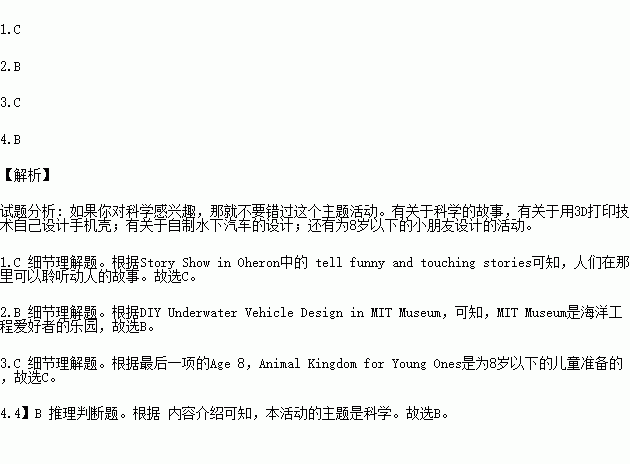题目内容
A
Welcome to Our Festival March 7 2016
Story Show in Oheron Adults 8:00 pm -10:00 pm Join in us for an evening of true, personal stories about science. Come to the only show where you can hear people——scientists, not-scientists, and half-scientists——tell funny and touching stories about the role of science in their lives. Cost: $10 |
Make Your Own iPhone Case through Toysinbox 3D Printing Families & Teens & Adults 10:00 am – 12:30 pm In this workshop, you will learn to design and 3D print your own iPhone case. First, you will learn how to use a 3D printer. Next, you will design a 3D model for your iPhone case that will have a lovely pattern and your name. Once you create the model, you will print it out on our 3D printers. A 3D printing worker will guide you through this process step-by-step. Come and enjoy this fun and unique learning experience! Cost: $35 |
DIY Underwater Vehicle Design in MIT Museum Teens 2:00 pm – 5:00 pm Dive into the world of ocean engineering by designing and building an underwater vehicle! Test your vehicle in large tanks on the Museum’s floor. Show off your engineering creations and share your design process with Museum visitors. Cost: $15, Ages 12 |
Animal Kingdom for Young Ones in Museum of Science, Boston Families 9:30 am – 2:00 pm Join us for a day of hands-on science fun designed especially for pre-schoolers! Activities include the Museum’s popular “Live Animal Story Time” shows and a talk about baby animals and book-signing by children’s book authors. Drop in on special live animal visits and activities in the exhibition halls, as well as design challenges and lab activities——all created with your young scientist in mind! Cost: Free, Ages Pre-kindergarten——Age 8 |
1.What can people do in Story Show?
A. Do role-play games.
B. Put on science shows.
C. Hear touching stories.
D. Meet authors of the books.
2.If you are interested in ocean engineering, you will probably attend_______________.
A. Story Show
B. DIY Underwater Vehicle Design
C. Make Your Own iPhone Case
D. Animal Kingdom for Young Ones
3.Animal Kingdom for Young Ones is designed for ____________.
A. adults
B. children of all ages
C. kids under 8 years old
D. children aged twelve and older
4.What is the subject of the festival?
A. Sports. B. Science.
C. Literature. D. Education.



 e professor knew 6. the student complained about. He explained to him with a smile: “This is the method I have learnt---the 7. (hard) you work independently, the better solutions you will find. If you can make full use of the books, you will 8. (probable) become a good lawyer in the future.”
e professor knew 6. the student complained about. He explained to him with a smile: “This is the method I have learnt---the 7. (hard) you work independently, the better solutions you will find. If you can make full use of the books, you will 8. (probable) become a good lawyer in the future.”